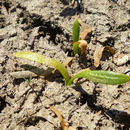en
names in breadcrumbs


Sagittaria montevidensis is a species of flowering plant in the water-plantain family Alismataceae. Common names include giant arrowhead[3] and California arrowhead.
Sagittaria montevidensis is a robust, stemless, rhizomatous, aquatic plant. The young ribbon-like leaves grow submerged, while the leaves of older plants emerge above the water surface. The leaves are sagitatte and glabrous, up to 28 centimeters long and 23 centimeters wide. Its terete, spongy petioles may reach a length of more than 0.75 m (2.5 ft) and are up to 3 inches thick.
Inflorescences are typically shorter than the leaves and decumbent. Flowers are in whorls or pairs at nodes and have a diameter of two to three centimeters.. They have three petals, each of which is white with a striking wine-colored stain, and three green sepals. The thick pedicels are as long as 5 cm (2.0 in). Flowering occurs from June to September.[4]
Sagittaria montevidensis is widespread in wetlands of North America (United States, Canada, Mexico) and South America (Brazil, Bolivia, Ecuador, Peru, Argentina, Chile, Paraguay, Uruguay).[1] In North America, the distribution is disjunct, primarily in a wide area from West Virginia to Texas to South Dakota, but with isolated occurrences in New Brunswick, Maine, Connecticut, New York, New Jersey, California, Florida and Alabama[5] It is reportedly naturalized in Spain, Tanzania, and the Island of Java in Indonesia.[6]
It grows preferentially at the edges of ponds, in shallow and often only temporarily existing waters.
Leaves of Sagittaria montevidensis at the Orto Botanico dell'Università di Genova
Sagittaria montevidensis is a species of flowering plant in the water-plantain family Alismataceae. Common names include giant arrowhead and California arrowhead.